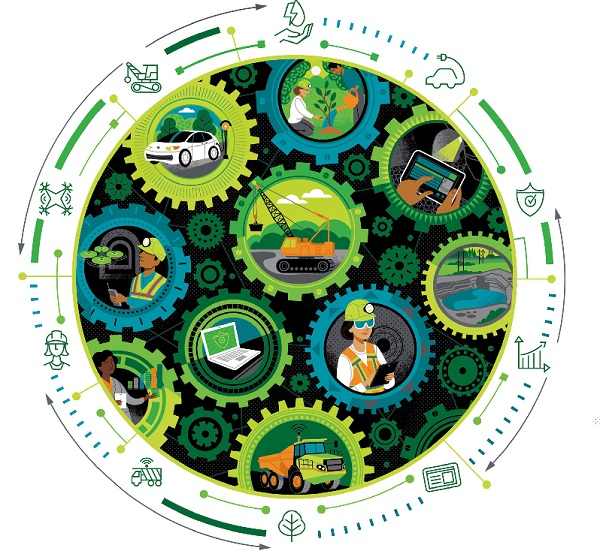
Tracking the Trends – Deloitte lists key drivers of miners’ future fortunes or misfortunes

In a new report on the global mining industry, business consulting firm Deloitte, identifies ten key drivers of change which they say, will force the industry to make sweeping changes over the next decade.
In its 11th annual ‘Tracking the Trends’ report, Deloitte’s global mining professionals under the leadership of Philip Hopwood, again draw on their knowledge and experience to offer mining companies insights that can be leveraged in their ongoing pursuit of productivity, capital discipline, strategy development, and sustainable growth.
The report also analyse a number of disruptors which mining companies will have to incorporate in their future business models.
“Mining companies now need to determine how to operate in a market characterized by constant disruption, volatility, rising stakeholder demands, a widening talent gap, dwindling access to key inputs such as energy and water, and a Chinese economy growing at under seven percent,” stated Deloitte.
The report’s executive summary lists three key messages, each of which will have a marked impact on mining operations, regardless of locality.
First, mining companies will have to deal with divergent views on value. Stakeholders and shareholders do not always agree on the company’s mandate but for future success, a diversity of opinions will have to be incorporated in the business model.
Second, the report anticipates a major impact from technology and artificial intelligence. Advances in finance platforms, sensor technology, autonomous vehicles, cloudbased solutions, and analytics are paving the way for the design of a digital mine.
Third, it is crucial that mining companies understand the needs and perceptions of people both inside and outside the organisation. Companies must build a more diverse workplace and address succession planning while fostering loyalty and retention among existing employees. At the same time companies must reach out more to local communities, governments, and consumers so they can be seen as more transparent and receptive.
The Ten Most Important Mining Trends
Turning to the issues themselves, the report first advises that mining strategies require rethinking. A departure away from the simple cost benefit structure is needed where corporate strategies recognise and include the many demands posed by players outside the immediate periphery.
Consumers, governments, and communities are becoming more vocal and irrevocably altering industry dynamics. As a result, corporate social responsibility is now morphing into stakeholder engagement programmes, and social license to operate is becoming a pivotal strategic issue that will either differentiate mining companies or derail them.
The second issue is the role of analytics and artificial intelligence. Identifying three horizons in the application of AI, the report states that mining companies largely still operates only in the first horizon where machine intelligence must be assisted by human intervention. Only by investing in and progressing up the AI horizons, will mining companies be able to exploit the full potential of this resource, advancing to a level where unpredictables, emerging risks and changing expectations all form part of the strategy to navigate a mine’s future.
Issue number 3 is risk management in the digital era. “The current risk landscape is characterized by a host of issues such as mounting tariffs and sanctions, potential trade wars, cyber threats, uncertain tax and royalty regimes, rising input costs, heightened scrutiny from the investment community, environmental disasters, and infrastructure breakdowns.” A more holistic view of risk is required and this must be included in internal audit controls, both at operational and enterprise level.
Innovation, integration and digitizing the supply chain resort under issue number 4. “To create a more interconnected and responsive supply chain, mining companies need to stop thinking in linear terms and imagine instead a circular system, the [so-called] digital supply network. The ultimate goal is to leverage advanced algorithms, AI, and machine learning to turn data into insights that allow companies to reduce their capital expenditures, respond to changing project requirements quickly, and optimize mine planning to integrate real-time changes.”
Issue number 5 is the need to go beyond mere statutory compliance and to actively drive sustainable social outcomes. If mining companies hope to drive beneficial social outcomes, they have to change their view of corporate social responsibility. It is not part of compliance cost, instead “a social enterprise is an organization whose mission combines revenue growth and profit-making with the need to respect and support its environment and stakeholder network.”
Featuring at issue number 6 is the critical question of the dependence on the water-energy nexus. Making the case for a systemic approach, the report states, “True value from energy management can only be derived by addressing the triple bottom line of social, environmental, and financial performance. This requires companies to approach energy management as an integrated corporate initiative.”
Similarly, strategies to contend with either too little or too much water, must see water as a valuable resource, subject to exactly the same management scrutiny as energy.
The seventh issue is the need to decode capital projects. Mining projects are by definition long-term investments requiring a very deep look into the future based on probable scenarios. Mining history has shown how difficult this is with many mines posting sub-par returns, cost overruns and impairment charges. This often inhibited mining investors’ appetite for new investments, resulting in commodity shortages and disruptions in the value chain. “With the cycle turning, mining companies will need to engage in a wave of new capital projects to offset production declines and meet demand.”
Issue number 8 refers to people and the environment in which they work, and the need for a new future model that makes provision for individual mobility. As digitization in mining grows, so does the need for specialists increase. Talent and its retention or succession, therefore becomes a critical pillar of a mining operation.
This flows into issue number 9, which is turning the reality of diversity and inclusion, into an integrated part of any mine’s operations, both at mining and enterprise level. Mining companies must also include this in their public relations strategies, making it clear that inclusiveness is their operating paradigm.
The last issue, number 10, is the insistence that provenance must be demonstrable. Mining companies must be able to prove the origin of the minerals they mine and market as well as the conditions under which any commodity is mined, procured, processed and distributed. New technologies, for instance electric vehicle, have changed irrevocably the demand curves for certain commodities, but modern consumers are more and more questioning the origin of the material on which new technology rides. Ethically-sourced minerals will become a key aspect of mining companies’ ability to supply commodities to the large factories where new technology finds application in everyday utilities.
“This is putting unprecedented pressure on mining companies to create a more transparent interface with their customers and driving the adoption of technologies such as blockchain to enhance the traceability of commodities.”
Deloitte’s full Tracking the Trends 2019 report can be downloaded from
https://www2.deloitte.com/za/en/pages/energy-and-resources/articles/tracking-the-trends.html











































